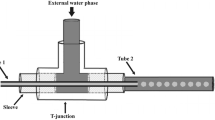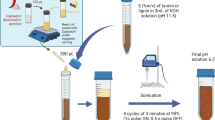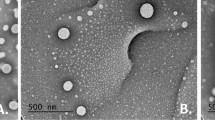Abstract
Lignin-based carriers are a promising biodegradable platform for the delivery system. Lignin with a much smaller particle size had been utilized as the encapsulation matrix for the active ingredient from herbicide, pelargonic acid (PA). PA is a saturated fatty acid with nine carbons (C9:0) that occurs naturally in a variety of vegetables and fruits. The PA-lignin emulsion had successfully formulated with the optimum condition stirring speed of 5000 rpm for 5 min in pH 5, with a droplet size of about 100 nm. There was no noticeable separation for 14 days and the zeta potential value was confirmed in the stable range. The presence of lignin as a carrier of pelargonic acid was proven not to solely disrupt the pelargonic acid effect on killing weeds. The residue analysis also showed a decrease after seven days of treatment. This finding showed the green technology platform to substitute chemical-based herbicides, which have potential applications in agricultural fields.

Similar content being viewed by others
Data availability
The data supporting the findings of this study are available upon reasonable request from the corresponding author, [WKR].
References
V. Sharad, Herbicides : history , classification and genetic manipulation of plants for herbicides: history, classification and genetic manipulation of plants for herbicide (2015). https://doi.org/10.1007/978-3-319-09132-7.
C. Wesseling, B.V.W. De Joode, C. Ruepert, C. León, P. Monge, H. Hermosillo, L.J. Partanen, Paraquat in develo** countries. Int. J. Occup. Environ. Health. 7, 275–286 (2001). https://doi.org/10.1179/107735201800339209
W. Wibawa, R. Mohamad, D. Omar, A.S. Juraimi, Less hazardous alternative herbicides to control weeds in immature oil palm. Weed Biol. Manag. 7, 242–247 (2007). https://doi.org/10.1111/j.1445-6664.2007.00263.x
A.V. Barker, R.G. Prostak, Management of vegetation by alternative practices in fields and roadsides. Int. J. Agron. 2014, 12 (2014). https://doi.org/10.1155/2014/207828
I. Travlos, E. Rapti, I. Gazoulis, P. Kanatas, A. Tataridas, I. Kakabouki, P. Papatylianou, The herbicidal potential of different pelargonic acid products and essential oils against several important weed species. Agronomy 10, 1–13 (2020). https://doi.org/10.3390/agronomy10111687
S. Beckers, S. Peil, F.R. Wurm, Pesticide-loaded nanocarriers from lignin sulfonates—a promising tool for sustainable plant protection. ACS Sustain. Chem. Eng. 8, 18468–18475 (2020). https://doi.org/10.1021/acssuschemeng.0c05897
M. Fern, Lignin-polyethylene glycol matrices and ethylcellulose to encapsulate highly soluble herbicides. J. Appl. Polym. Sci. (2018). https://doi.org/10.1002/app.41422
Q. Tang, Y. Qian, D. Yang, X. Qiu, Y. Qin, Lignin-based nanoparticles : a review on their preparations and applications. Polymers (Basel). 12, 12–16 (2020). https://doi.org/10.3390/polym12112471
M.H. Sipponen, H. Lange, C. Crestini, A. Henn, M. Österberg, Lignin for nano- and microscaled carrier systems: applications, trends, and challenges. Chemsuschem 12, 2039–2054 (2019). https://doi.org/10.1002/cssc.201900480
R. Weiss, E. Ghitti, M. Sumetzberger-Hasinger, G.M. Guebitz, G.S. Nyanhongo, Lignin-based pesticide delivery system. ACS Omega 5, 4322–4329 (2020). https://doi.org/10.1021/acsomega.9b04275
T.O. Machado, S.J. Beckers, J. Fischer, B. Mu, C. Sayer, K. Landfester, F.R. Wurm, P.H.H. De Arau, Bio-based lignin nanocarriers loaded with fungicides as a versatile platform for drug delivery in plants. Biomacromol 2020(21), 2755–2763 (2020). https://doi.org/10.1021/acs.biomac.0c00487
M. Nazari, M. Amin, Preparation and characterization of water in sesame oil microemulsion by spontaneous method. J. Food Process. Eng. 1, 1–8 (2019). https://doi.org/10.1111/jfpe.13032
E. Melro, A. Filipe, D. Sousa, A.J.M. Valente, A. Romano, F.E. Antunes, B. Medronho, Dissolution of kraft lignin in alkaline solutions. Int. J. Biol. Macromol. 148, 688–695 (2020). https://doi.org/10.1016/j.ijbiomac.2020.01.153
N.H.M. Saari, L.S. Chua, Nano-based products in beverage industry, Elsevier Inc., 2019. https://doi.org/10.1016/B978-0-12-816677-2.00014-4.
M. Muñoz, N. Torres-pag, R. Peiro, R. Guijarro, A.M. Sánchez-Moreiras, M. Verdeguer, Phytotoxic effects of three natural compounds: pelargonic acid, carvacrol, and cinnamic aldehyde, against problematic weeds in mediterranean crops. Agron. J. 20, 1 (2021). https://doi.org/10.3390/agronomy10060791
G. Dev Kumar, K. Mis Solval, A. Mishra, D. Macarisin, Antimicrobial efficacy of pelargonic acid micelles against salmonella varies by surfactant, serotype and stress response. Sci. Rep. 10, 1–13 (2020). https://doi.org/10.1038/s41598-020-67223-y
M. Pishnamazi, H.Y. Ismail, S. Shirazian, J. Iqbal, G.M. Walker, M.N. Collins, Application of lignin in controlled release: development of predictive model based on artificial neural network for API release. Cellulose 26, 6165–6178 (2019). https://doi.org/10.1007/s10570-019-02522-w
M. Daaou, D. Bendedouch, Water pH and surfactant addition effects on the stability of an Algerian crude oil emulsion. J. Saudi Chem. Soc. 16, 333–337 (2012). https://doi.org/10.1016/j.jscs.2011.05.015
S.P. Hariyatno, V. Paramita, R. Amalia, The effect of surfactant, time, and speed of stirring in the emulsification process of soybeaan oil in water. J. Vocat. Stud. Appl. Res. 3, 21–25 (2021). https://doi.org/10.14710/jvsar.v3i1.10918
Z. Hussain, S. Sahudin, Preparation, characterization and colloidal stability of chitosan-tripolyphosphate nanoparticles: optimization of formulation and process parameters. Int. J. Pharm. Pharm. Sci. 8, 297–308 (2016)
C.N. Lunardi, A.J. Gomes, F.S. Rocha, J. De Tommaso, G.S. Patience, Experimental methods in chemical engineering: zeta potential. Can. J. Chem. Eng. 99, 627–639 (2021). https://doi.org/10.1002/cjce.23914
G. Shulga, S. Livcha, B. Neiberte, A. Verovkins, S. Vitolina, E. Zhilinska, The effect of pH on the ability of different lignins to stabilize the oil-in-water emulsion. IOP Conf. Ser. Mater. Sci. Eng. 500, 1 (2019). https://doi.org/10.1088/1757-899X/500/1/012011
C. Nie, G. Han, J. Ni, S. Guan, H. Du, Y. Zhang, H. Wang, Stability dynamic characteristic of oil-in-water emulsion from alkali-surfactant-polymer flooding. ACS Omega 6, 19058–19066 (2021). https://doi.org/10.1021/acsomega.1c02367
C. Chung, A. Sher, P. Rousset, E.A. Decker, D.J. McClements, Formulation of food emulsions using natural emulsifiers: utilization of quillaja saponin and soy lecithin to fabricate liquid coffee whiteners. J. Food Eng. 209, 1–11 (2017). https://doi.org/10.1016/j.jfoodeng.2017.04.011
B. Huang, C. Wang, W. Zhang, C. Fu, H. Liu, H. Wang, Study on the stability of produced water from alkali/surfactant/polymer flooding under the synergetic effect of quartz sand particles and oil displacement agents. Processes. 8, 1 (2020). https://doi.org/10.3390/pr8030315
Charles Ross & Son Company, Improve Emulsion Stability Through Ultra-high Shear Mixing, pp. 1–2 (2012).
R. Yulianingsih, S. Gohtani, The influence of stirring speed and type of oil on the performance of pregelatinized waxy rice starch emulsifier in stabilizing oil-in-water emulsions. J. Food Eng. 280, 109920 (2020). https://doi.org/10.1016/j.jfoodeng.2020.109920
J. Feng, M. Roché, D. Vigolo, L.N. Arnaudov, S.D. Stoyanov, T.D. Gurkov, G.G. Tsutsumanova, H.A. Stone, Nanoemulsions obtained via bubble-bursting at a compound interface. Nat. Phys. 10, 606–612 (2014). https://doi.org/10.1038/nphys3003
Z. Wei, Y. Yang, R. Yang, C. Wang, Alkaline lignin extracted from furfural residues for pH-responsive Pickering emulsions and their recyclable polymerization. Green Chem. 14, 3230–3236 (2012). https://doi.org/10.1039/c2gc36278c
Z. Hanifah, T.A. Ismoyo, R.A. Nugrahani, N.H. Fithriyah, The effects of stirring time at high speed on particle size and dispersion of rice bran γ -oryzanol nanocream, in: 5th Int. Conf. Innov. Res. Sci. Technol. Cult., pp. 59–62 (2019).
A. Gupta, H.B. Eral, T.A. Hatton, P.S. Doyle, Nanoemulsions : formation, properties and applications. R. Soc. Chem. (2016). https://doi.org/10.1039/C5SM02958A
J. Yao, F. Lin, H.S. Kim, J. Park, The effect of oil viscosity on droplet generation rate and droplet size in a T-Junction microfluidic droplet generator. Micromachines. 10, 1 (2019). https://doi.org/10.3390/mi10120808
R. Ciriminna, A. Fidalgo, L.M. Ilharco, M. Pagliaro, Herbicides based on pelargonic acid: Herbicides of the bioeconomy. Biofuels Bioprod. Biorefining. 13, 1476–1482 (2019). https://doi.org/10.1002/bbb.2046
S. Lebecque, L. Lins, F.E. Dayan, M.L. Fauconnier, M. Deleu, Interactions between natural herbicides and lipid bilayers mimicking the plant plasma membrane, Front. Plant Sci. 10, 1–11 (2019). https://doi.org/10.3389/fpls.2019.00329
Acknowledgements
The authors thank the facilities, scientific and technical support from Advanced Characterization Laboratories Serpong, through E- Layanan Sains, National Research and Innovation Agency (BRIN).
Funding
The authors are grateful for the research funding obtained from the JASTIP-Net 2021 Project number: 3-14.
Author information
Authors and Affiliations
Corresponding author
Ethics declarations
Competing Interest
The authors have disclosed no competing interests.
Additional information
Publisher's Note
Springer Nature remains neutral with regard to jurisdictional claims in published maps and institutional affiliations.
Rights and permissions
Springer Nature or its licensor (e.g. a society or other partner) holds exclusive rights to this article under a publishing agreement with the author(s) or other rightsholder(s); author self-archiving of the accepted manuscript version of this article is solely governed by the terms of such publishing agreement and applicable law.
About this article
Cite this article
Restu, W.K., Septiyanti, M., Triwulandari, E. et al. The Preparation of Nanoemulsion Formulation from Pelargonic Acid in Lignin Carrier and Its Application to Weeds. J. Inst. Eng. India Ser. E 104, 297–303 (2023). https://doi.org/10.1007/s40034-023-00272-w
Received:
Accepted:
Published:
Issue Date:
DOI: https://doi.org/10.1007/s40034-023-00272-w




